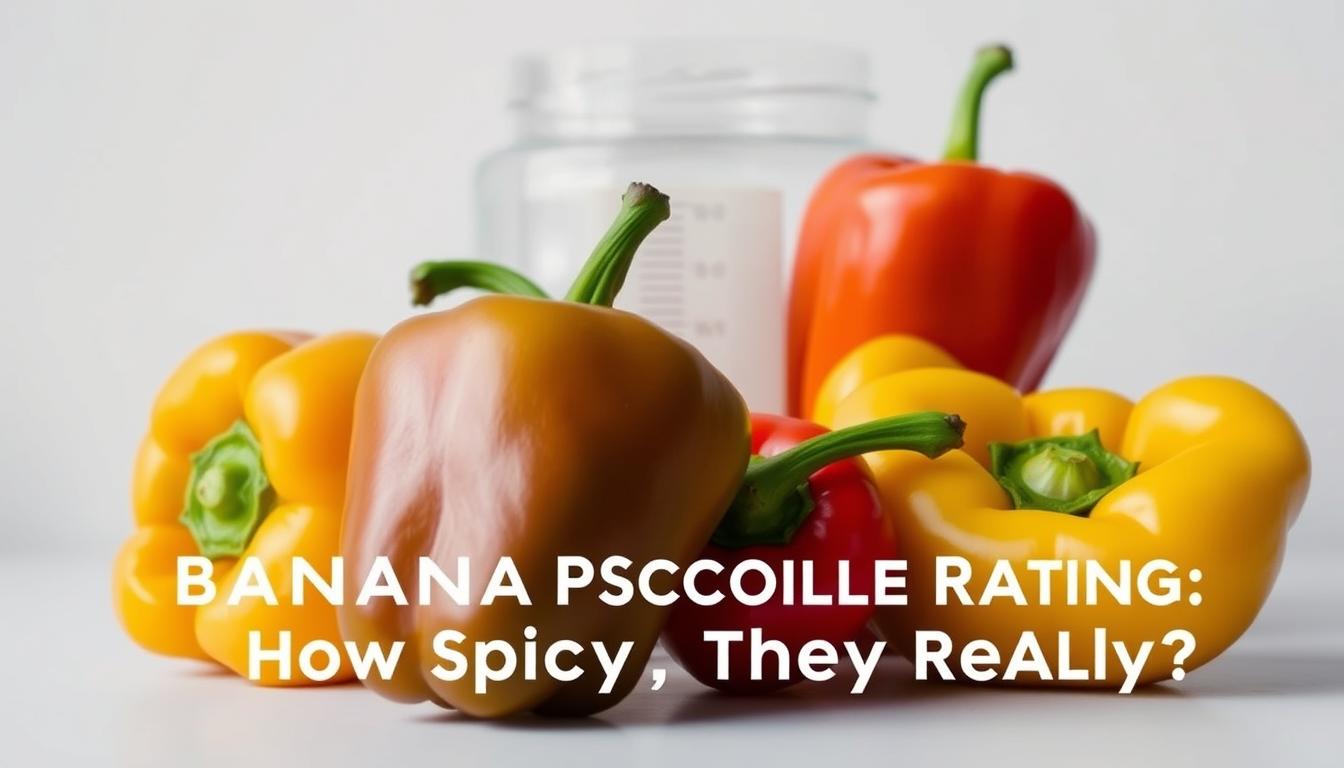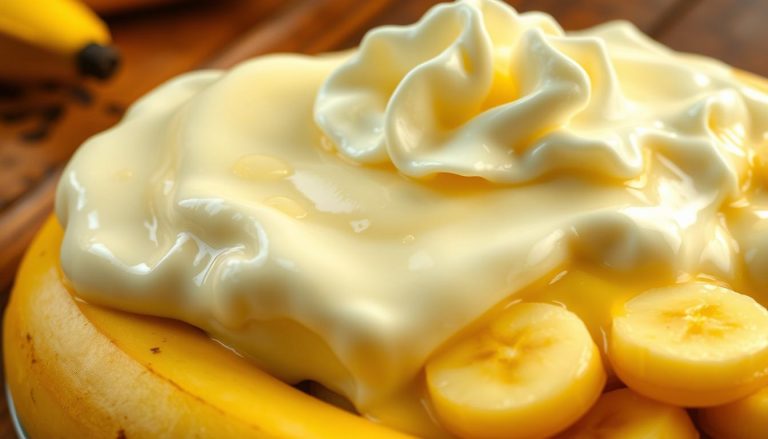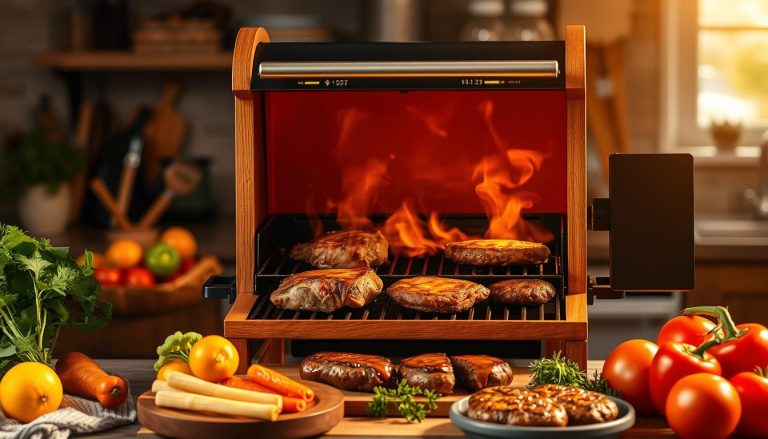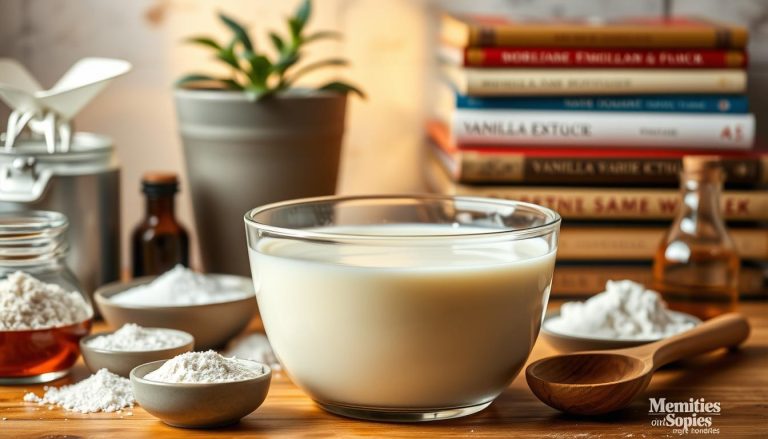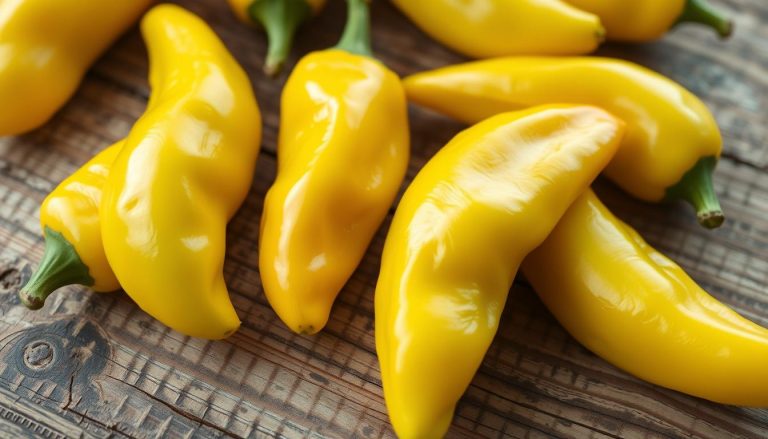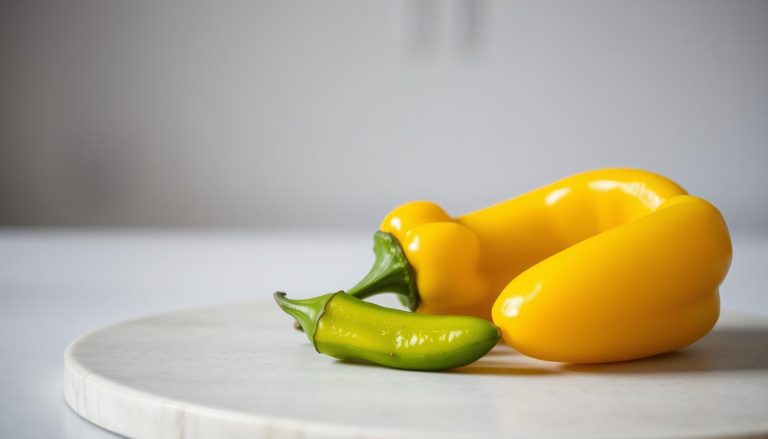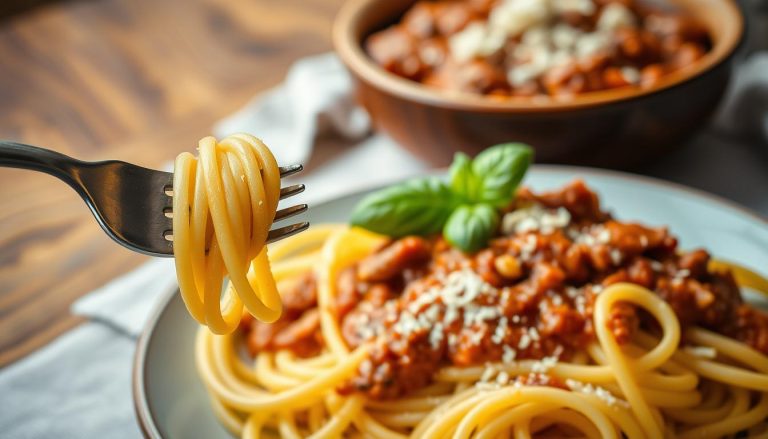Banana Pepper Scoville Rating: How Spicy Are They Really?
Ever wondered about the heat in sunny yellow banana peppers? My journey started with a surprising discovery. I bit into a banana pepper, expecting mildness. But, I felt a subtle warmth that surprised me.
Banana pepper scoville ratings might surprise you. These peppers are more than just a kitchen item. They mix flavor with mild heat, making any dish better. Whether you cook at home or love spices, knowing the banana pepper scoville scale opens up new cooking possibilities.
We’ll explore banana peppers’ heat levels and compare them to other peppers. We’ll see why they’re a secret ingredient in many American kitchens. Get ready to learn more about these amazing peppers.
Table of Contents
Understanding the Scoville Heat Scale
The Scoville Heat Scale is key for measuring pepper spiciness, like banana peppers. It was created by pharmacist Wilbur Scoville in 1912. This scale shows how spicy different chili types are.
Knowing how banana peppers’ heat is measured is important. The banana pepper scoville rating tells you how spicy they are.
How Heat Levels Are Measured
The Scoville scale measures capsaicin, the heat chemical in peppers. Scientists use High-Performance Liquid Chromatography (HPLC) to find out the exact heat level.
- Capsaicin concentration determines spiciness
- Measured in Scoville Heat Units (SHU)
- Higher numbers mean more intense heat
Common Peppers on the Scale
| Pepper Type | Scoville Heat Units (SHU) |
|---|---|
| Bell Pepper | 0 SHU |
| Banana Pepper | 0-500 SHU |
| Jalapeño | 2,500-8,000 SHU |
| Habanero | 100,000-350,000 SHU |
Why the Scale Matters for Cooking
Knowing the Scoville scale helps pick the right pepper for your dish. It lets you control the heat and make dishes that taste just right.
Pro tip: Always check the Scoville rating before adding peppers to your cooking to avoid unexpected spiciness!
What Are Banana Peppers: An Introduction
Banana peppers are a unique and versatile pepper variety. They get their name from their banana-like shape. As they ripen, they change color from pale yellow to bright red. They offer a mild and tangy flavor, making them popular in many cuisines.
Exploring banana peppers, you’ll find they belong to the Capsicum annuum species. They have a mild heat and sweet undertones. Typically, they are 2-3 inches long, with a smooth, waxy exterior and a crisp texture.
- Shape: Long and curved, similar to a banana
- Color: Ranges from pale yellow to bright red
- Heat level: Mild (0-500 Scoville Heat Units)
- Flavor profile: Tangy and slightly sweet
Banana peppers are incredibly versatile in the kitchen. They can be pickled, fresh, or used in various dishes. Their mild nature makes them perfect for those who enjoy a hint of pepper flavor without intense heat. They’re great on sandwiches, in salads, or in cooking, adding a unique taste to many recipes.
Culinary enthusiasts love banana peppers for their adaptability. They can be stuffed, roasted, grilled, or eaten raw. This makes them a favorite among home cooks and professional chefs.
Banana Pepper Scoville Rating Explained
Banana peppers have a unique taste that many love. Knowing their scoville rating helps you enjoy them more in your cooking.
Banana peppers are quite mild compared to others. They usually have a scoville rating of 0-500. This makes them perfect for those who like a little spice.
Mild vs. Hot Varieties
Not all banana peppers are the same. Their heat can change due to:
- Growing conditions
- Pepper maturity
- Specific subspecies
- Soil composition
Heat Range Variations
In the debate between pepperoncini and banana peppers, both are quite mild. Pepperoncini usually have a rating of 100-500 scoville units. Banana peppers can be even milder, sometimes almost zero.
Comparing to Other Common Peppers
Here’s a quick comparison to understand their heat:
- Bell Peppers: 0 scoville units
- Banana Peppers: 0-500 scoville units
- Jalapeños: 2,500-8,000 scoville units
This shows why banana peppers are great for adding flavor without too much heat.
Growing and Harvesting Banana Peppers
Banana peppers are great for home gardens with the right care. To grow them well, you need to know their best growing spots. They love warm, sunny places and need special care to grow lots of peppers.
- Sunlight requirements: Minimum 6-8 hours of direct sunlight daily
- Soil type: Well-draining, fertile soil with pH between 6.0-6.8
- Temperature range: 70-85°F for optimal growth
- Watering needs: Consistent moisture without waterlogging
Planting banana peppers needs careful timing. Start seeds indoors 8-10 weeks before the last frost. Transplant seedlings outdoors when soil is 60°F. Plant them 18-24 inches apart for good air flow.
Harvesting banana peppers is easy. Look for peppers that are yellow or bright green. Use sharp scissors to cut them from the plant, leaving a small stem. Banana peppers are ready to pick 60-75 days after planting.
Pro tip: Regularly picking peppers helps them keep growing. Choose firm, glossy peppers for the best taste and texture in your cooking.
Pepperoncini vs Banana Peppers: Key Differences
Exploring the world of peppers can be exciting. Knowing the differences between pepperoncini and banana peppers can make your cooking better. These peppers might look alike, but they have their own special qualities.
At first, pepperoncini and banana peppers seem the same. But, they have different tastes, heat levels, and uses in cooking.
Heat Level Comparison
Pepperoncini and banana peppers have different heat levels. Pepperoncini are quite mild, with a heat of 100-500 Scoville Heat Units (SHU). Banana peppers are even milder, with a heat of 0-500 SHU. Pepperoncini are a bit spicier than banana peppers.
Physical Characteristics
- Pepperoncini:
- Wrinkled, thin skin
- Typically 2-3 inches long
- Light green to yellowish-green color
- Banana Peppers:
- Smooth, waxy skin
- Longer, usually 4-6 inches
- Bright yellow to yellow-green
Culinary Applications
Pepperoncini are known for their tangy, slightly spicy taste. They are often used in Greek and Italian dishes. Banana peppers, on the other hand, are sweeter and great for sandwiches, salads, and pickling.
Choosing between pepperoncini and banana peppers depends on what flavor and heat you want in your dish.
Culinary Uses of Banana Peppers
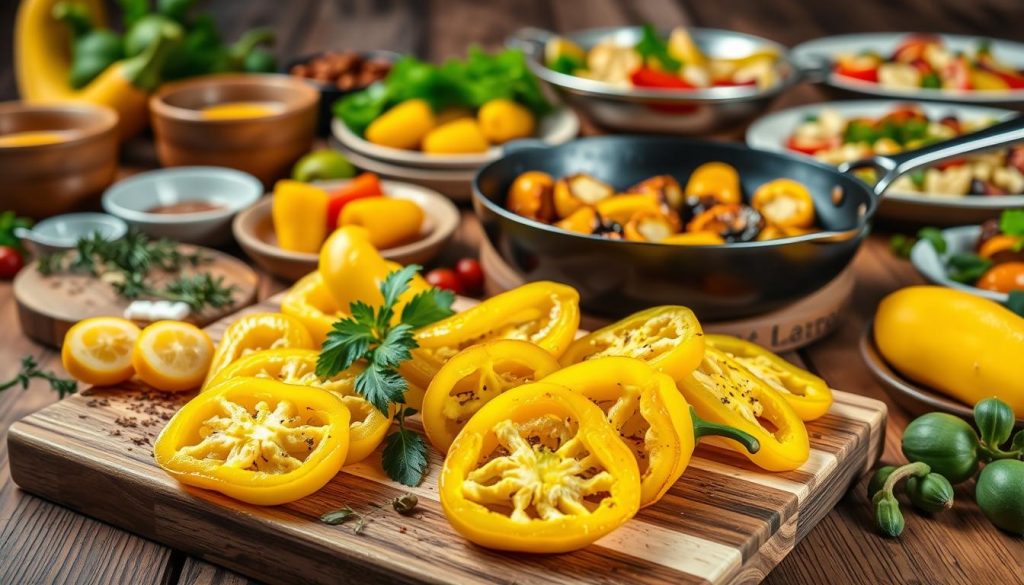
What are banana peppers? These peppers are culinary superstars. They can turn simple dishes into amazing meals. Their mild heat and tangy flavor make them great for many recipes.
Banana peppers are used in many ways. You can enjoy them in several ways:
- Raw in salads for a crisp, zesty crunch
- Pickled as a sandwich and pizza topping
- Stuffed with cheese or meat for appetizers
- Chopped into salsas and relishes
- Grilled alongside other vegetables
Their unique flavor profile makes them great for both cold and hot dishes. Chefs and home cooks love banana peppers for their ability to add brightness without overwhelming heat. They’re perfect for adding flavor to Italian subs or spicy Mexican dishes.
Popular recipes with banana peppers include Italian antipasto platters, Cincinnati-style chili dogs, and Mediterranean salads. Their versatility lets you try new things in your kitchen. Add a splash of color and a hint of tang to your favorite meals.
Health Benefits and Nutritional Value
Banana peppers are more than just a tasty snack. They are packed with nutrients that boost your health. With few calories and lots of flavor, they are a great choice for any meal.
Eating banana peppers can greatly benefit your body. They are full of important nutrients that support your health. Adding them to your diet can make it more balanced and nutritious.
Vitamin and Mineral Content
Banana peppers are rich in essential nutrients:
- Vitamin C: Supports immune system function
- Vitamin B6: Promotes brain health
- Vitamin A: Enhances vision and skin health
- Potassium: Regulates blood pressure
- Folate: Supports cellular metabolism
Capsaicin Benefits
Even though they have a low Scoville rating, banana peppers contain capsaicin. This compound has many health benefits:
- Reducing inflammation
- Boosting metabolism
- Supporting cardiovascular health
- Potentially alleviating pain
Adding banana peppers to your meals is a tasty way to improve your nutrition. They support your overall health and well-being.
Storing and Preserving Banana Peppers
Learning how to store banana peppers right can extend their enjoyment for months. These mild, yellow-green peppers are great for preserving. They keep their crisp texture and flavor through several methods.
To keep fresh banana peppers, store them in the fridge’s crisper drawer. Wrap them in a paper towel inside a bag with holes. This keeps moisture in check and prevents spoilage. Fresh peppers can last 1-2 weeks this way.
Preservation Techniques
- Refrigeration: Store in the crisper drawer at 40-45°F
- Pickling: Extend shelf life by several months
- Freezing: Maintain quality for up to 6 months
- Drying: Create long-lasting pepper flakes
Pickling is a great way to keep banana peppers fresh. Soak cleaned peppers in a vinegar brine with garlic and peppercorns. This method boosts their tangy taste and extends their life.
Freezing is perfect for long-term storage. Slice and seed the peppers, then bag them airtight. Frozen peppers are great in cooked meals and retain most of their texture.
Drying banana peppers is another option. Use a dehydrator or dry them in a warm, airy spot. Dried peppers can be ground into flakes or powder for seasoning.
Popular Recipes Featuring Banana Peppers
Banana peppers add a mild heat and tangy taste to many dishes. Knowing what banana peppers are opens up a world of tasty recipes. These recipes can make your cooking better and wow your guests.
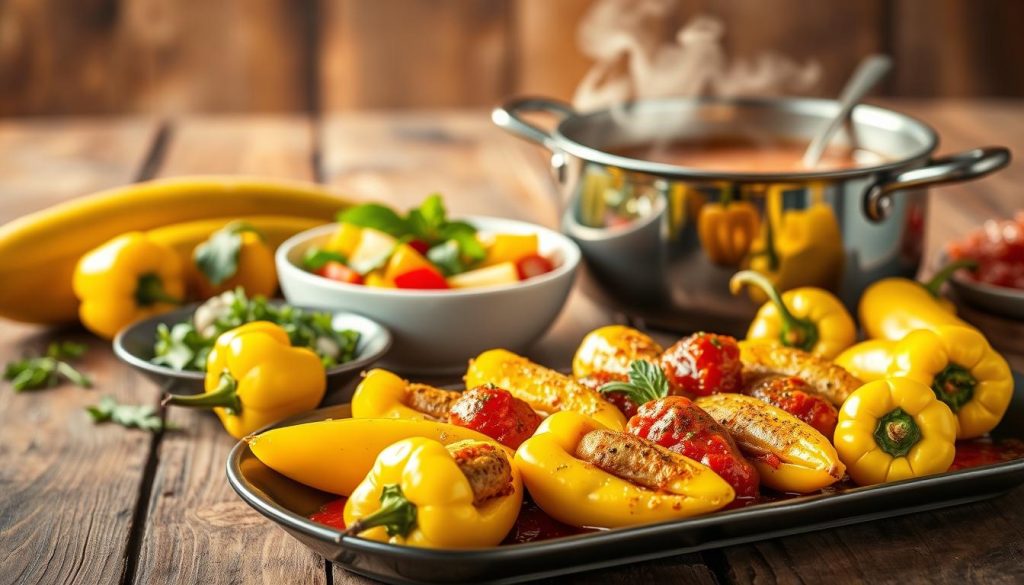
These peppers are great in both pickled and fresh dishes. They offer home cooks fun ways to add their special taste to meals.
Pickled Pepper Preparations
Pickling banana peppers is a classic method to keep and boost their flavor. It’s easy and makes them taste amazing:
- Create a vinegar-based brine with salt and spices
- Slice banana peppers into rings or leave whole
- Pack peppers into sterilized jars
- Pour hot brine over peppers
- Seal and refrigerate for maximum flavor
Stuffed Pepper Dishes
Banana peppers are great for stuffing. Their mild heat and shape make them perfect for fillings:
- Classic cream cheese and herb stuffing
- Spicy sausage and rice blend
- Vegetarian quinoa and vegetable mix
- Pulled chicken with melted cheese
These recipes show how versatile banana peppers are. They turn simple ingredients into the main attraction of your dishes.
Tips for Handling and Preparing Banana Peppers
Working with banana peppers needs careful techniques. This helps manage their heat and ensures safe preparation. Knowing how to handle these peppers lets you enjoy their flavor while controlling the spiciness.
When preparing banana peppers, protection is key. Always wear kitchen gloves to prevent skin irritation from capsaicin. The oils in banana peppers can cause burning sensations on sensitive skin, especially for those with lower tolerance to spicy foods.
- Select fresh, firm banana peppers with vibrant color
- Wash peppers thoroughly under cool running water
- Use a sharp knife for precise cutting
- Remove seeds to reduce banana pepper scoville heat intensity
Controlling the pepper’s heat involves strategic preparation. Removing the inner membranes and seeds significantly reduces spiciness. For milder dishes, carefully scrape out these sections. If you prefer more heat, keep some seeds intact.
| Preparation Method | Heat Level Impact |
|---|---|
| Remove All Seeds | Minimal Heat |
| Keep Some Seeds | Moderate Heat |
| Keep All Seeds/Membranes | Maximum Heat |
For cooking, slice banana peppers into rings or strips depending on your recipe. Consider roasting or pickling to enhance their natural flavors while moderating their banana pepper scoville characteristics. Practice and experimentation will help you develop your perfect pepper preparation technique.
Where to Buy and What to Look For
Looking for quality banana peppers can make your cooking better. These versatile veggies are available in many places, meeting different cooking needs and tastes.
Where can you find banana peppers? You have several reliable options:
- Local grocery stores produce sections
- Farmers markets during peak growing seasons
- Specialty food stores
- Online specialty produce retailers
Fresh vs. Pickled Selection
Choosing between fresh and pickled banana peppers depends on your recipe and taste. Fresh peppers are crunchy and full of flavor. Pickled ones are tangy and last longer.
Quality Indicators for Selection
Here’s what to check when picking banana peppers:
- Color: Bright yellow or greenish-yellow with no brown spots
- Firmness: Smooth skin without wrinkles
- Weight: Feels heavy for its size
- Texture: Smooth and glossy surface
Pro tip: Try locally grown banana peppers for the best taste and freshness.
Conclusion
Exploring banana peppers opens up a world of mild to moderate heat and amazing uses in cooking. Knowing the banana pepper scoville ratings helps you choose the right pepper for your dishes. Whether it’s for a light salad or a spicy sandwich, you’re set.
Learning about banana peppers is more than just their heat. They’re packed with nutrients, easy to prepare, and perfect for many recipes. Try pickling or stuffing them to make your meals stand out.
As you try out banana peppers, you’ll see how versatile they are. Your cooking will get better as you learn their unique taste and heat. Let your creativity run wild with banana peppers.
Discovering banana peppers is about more than just heat. It’s about broadening your taste, understanding flavors, and enjoying fresh ingredients. Your kitchen adventures with banana peppers are just starting.

